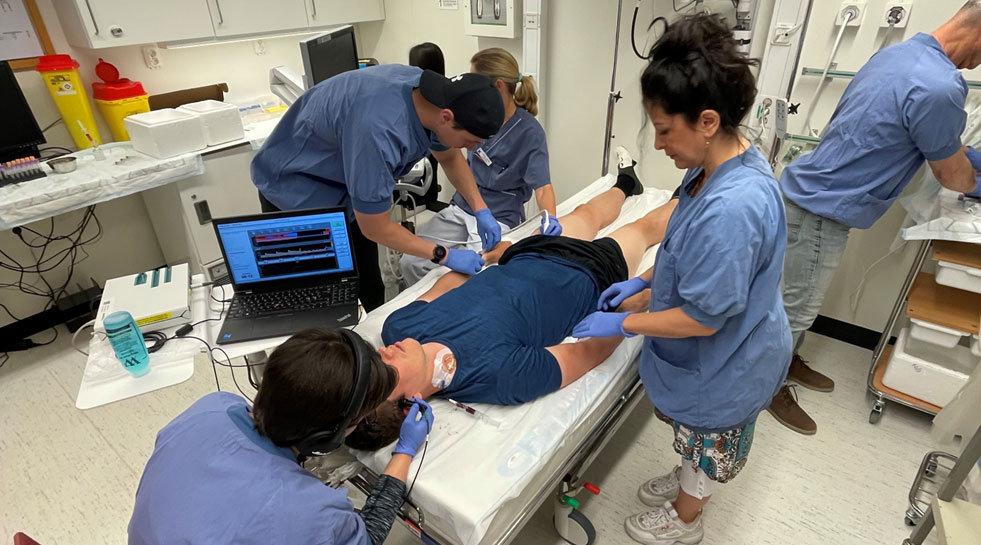Muscle to brain cross-talk in the molecular regulation of neuroplasticity
Project Leader
- Marcus Moberg
Department
- Department of Physiology, Nutrition and Biomechanics
Research Funders
- Knowledge Foundation
- Åke Wiberg Foundation
- Lars Hierta Memorial Foundation
- Swedish National Centre for Research in Sports
Abstract
Below you can read summaries about the project in English and/or Swedish. The information is taken from the publication database DiVA.
This project involves comparing the effects of different exercise intensities on neurotrophic signalling and cerebral blood flow, and in particular, investigating whether neurotrophic factors are taken up or emitted by the brain during physical and cognitive exercise, and describing how plasma and serum levels of exercise induced myokines relate to brain release of neurotrophic factors. The purpose of this research is 1.) to examine the effects of exercise at different intensities on blood flow in the middle cerebral artery and the release of BDNF (brain-derived neurotrophic factor) by the brain, 2.) to assess the relationship between BDNF release and various myokines and hepatokines considered to regulate brain function (including, lactate, ketones, irisin, cortisol and Gpld1), and 3.) to assess if lactate infusion into the blood can elicit changes in vascular function, and BDNF release from the brain. Transcranial Doppler will be used to measure blood flow velocity in the middle cerebral artery. Arterial, carotid and forearm venous blood will be sampled, at rest as well as during and after cycling exercise at three different intensities. In a separate experiment, blood will be sampled before and after infusion of lactate into the forearm vein, to mimic exercise induced increases in lactate. Blood entering and leaving the brain will be analysed for platelet count, plasma and serum BDNF levels as well as the potential molecular transducers of exercise induced BDNF production. This study will demonstrate the effect of exercise on brain release of BDNF and investigate the role of vascular function, cerebrovascular function, various metabolites and myokines, particularly lactate, in this process. Knowledge will be co-produced with our business partners Monark, SATS, Itrim, BioArctic and AbbVie who will contribute intellectually with intervention design, products and biomarker analyses.
Detta projekt handlar om att jämföra effekterna av olika träningsintensiteter på neurotrofisk signalering och cerebralt blodflöde, och i synnerhet att undersöka om neurotrofiska faktorer tas upp eller avges av hjärnan under fysisk träning, samt att beskriva hur plasma- och serumnivåer av ansträngningsinducerade myokiner relaterar till hjärnans frisättning av neurotrofiska faktorer. Syftet med denna forskning är 1.) att undersöka effekterna av träning vid olika intensiteter på blodflödet i den mellersta hjärnartären och frisättningen av BDNF (brain-derived neurotrophic factor) i hjärnan, 2.) att bedöma förhållandet mellan BDNF-frisättning och olika myokiner och hepatokiner som anses reglera hjärnans funktion (inklusive laktat, ketoner, irisin, kortisol och Gpld1), och 3.) att undersöka om laktatinfusion i blodet kan framkalla förändringar i kärlfunktion, och BDNF-frisättning från hjärnan. Transkraniell doppler kommer att användas för att mäta blodflödeshastigheten i den mellersta hjärnartären. Arteriellt, halspulsåder- och underarmsvenöst blod kommer att provtas, i vila samt under och efter cykelträning med tre olika intensiteter. I ett separat experiment kommer blodprov att tas före och efter infusion av laktat i underarmsvenen, för att efterlikna träningsinducerade ökningar av laktat. Blod som kommer in i och lämnar hjärnan kommer att analyseras med avseende på trombocytantal, plasma- och serumnivåer av BDNF samt de potentiella molekylära omvandlarna för ansträngningsinducerad BDNF-produktion. Denna studie kommer att visa effekten av träning på hjärnans frisättning av BDNF och undersöka rollen av vaskulär funktion, cerebrovaskulär funktion, olika metaboliter och myokiner, särskilt laktat, i denna process. Kunskapen kommer att samproduceras med våra affärspartners Monark, SATS, Itrim, BioArctic och AbbVie som kommer att bidra intellektuellt med interventionsdesign, produkter och biomarköranalyser.
Detta projekt ingår i forskningsmiljön E-PABS – ett excellenscenter för fysisk aktivitet, hjärnhälsa och hållbarhet.

Collaboration partners
The project is carried out in collaboration with a number of partners.
We work with:
- AbbVie
- BioArctic
- Monark
- Itrim
- SATS
E-PABS research environment
This project is part of the research environment E-PABS – a centre of excellence for physical activity, brain health and sustainability.
E-PABS has three main research themes, all of which focus on brain health:
- The Neurophysiology of Exercise
- Physical Activity Epidemiology
- Sustainable behavioural change
This project belongs to the theme "The Neurophysiology of Exercise".
Co-researcher
- Maria Ekblom, GIH, Department of Physical Activity and Health
- Abram Katz, GIH, Department of Physiology, Nutrition and Biomechanics
- Olga Tarassova, GIH, Department of Physiology, Nutrition and Biomechanics
- Yiwen Jiang, GIH, Department of Physical Activity and Health,
- Helena Wallin, Karolinska institutet
- Mats Jensen-Urstad, Karolinska institutet
- Nikola Drca, Karolinska institutet
Funding period
- 2022 - 2025
Project type
- Project grant
National Research Field
- Sport and Fitness Sciences
- Neurosciences
